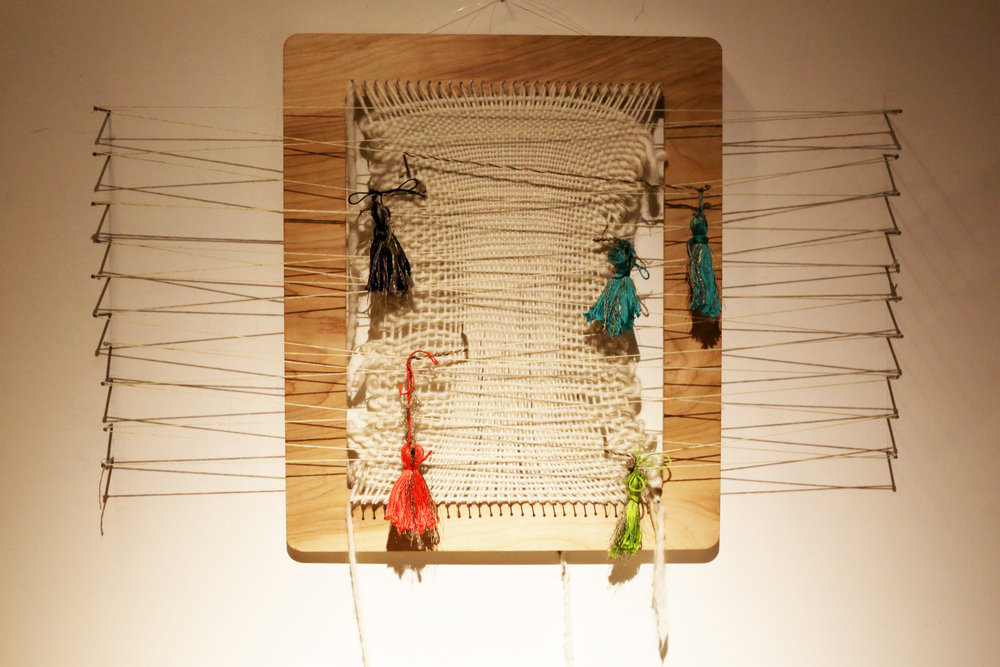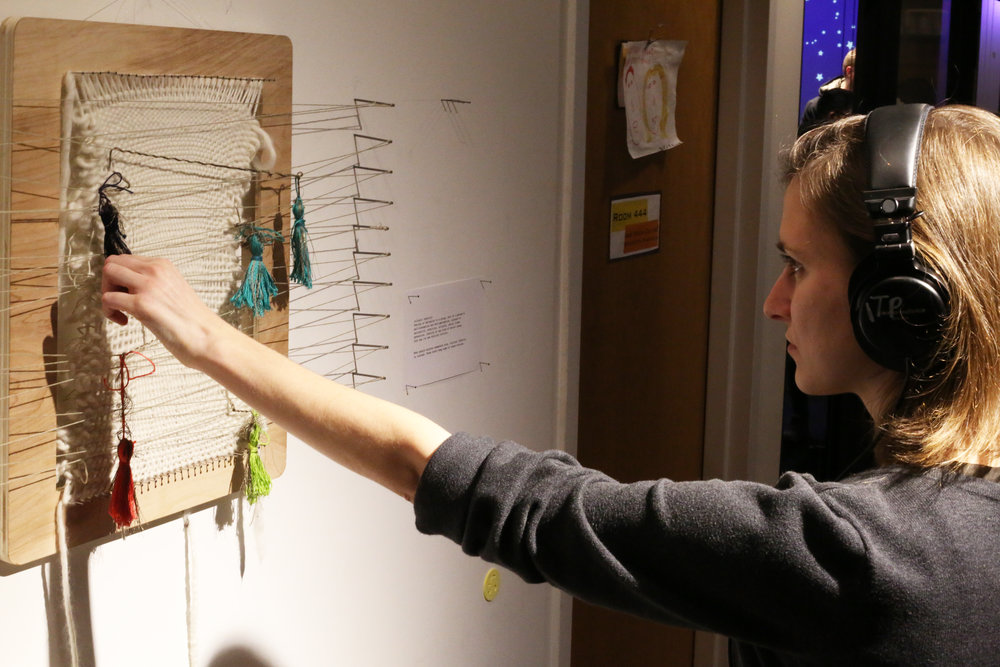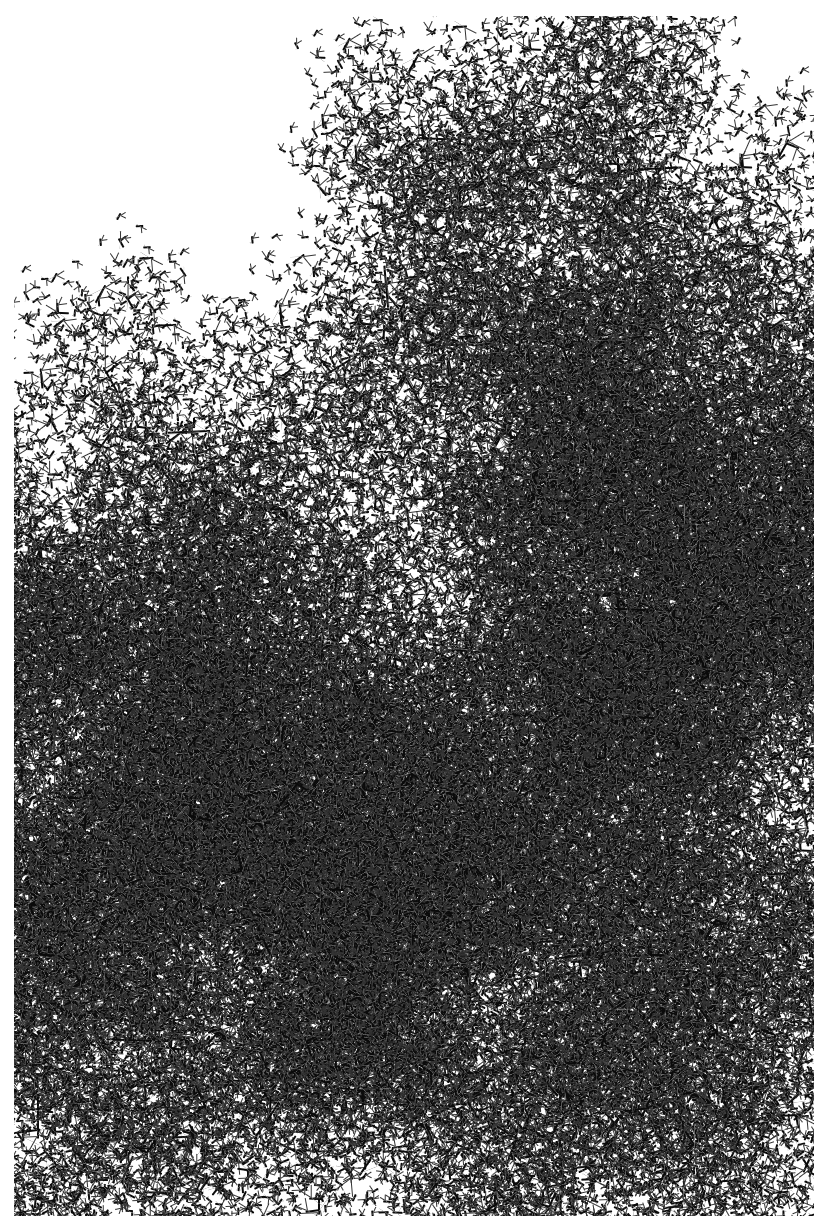 The conversation below with Francesca Rodriguez Sawaya began at a workshop last month called “Weaving to Code, Coding to Weave,” which was Rodriguez Sawaya led alongside Renata Gaui. Both women are designers, weavers, coders, and recent graduates from the Interactive Telecommunications Program (ITP) at NYU Tisch. After the workshop, I got in touch with Rodriguez Sawaya in hopes that she’d be willing to expand on some of the ideas she’d introduced me to. She very generously agreed, and the following conversation serves as a preview for her wonderful insights on coding and weaving, how these technologies incorporate unique modes of storytelling, and the opportunities for empowerment that they might offer women.
The conversation below with Francesca Rodriguez Sawaya began at a workshop last month called “Weaving to Code, Coding to Weave,” which was Rodriguez Sawaya led alongside Renata Gaui. Both women are designers, weavers, coders, and recent graduates from the Interactive Telecommunications Program (ITP) at NYU Tisch. After the workshop, I got in touch with Rodriguez Sawaya in hopes that she’d be willing to expand on some of the ideas she’d introduced me to. She very generously agreed, and the following conversation serves as a preview for her wonderful insights on coding and weaving, how these technologies incorporate unique modes of storytelling, and the opportunities for empowerment that they might offer women.
How did you personally become interested in weaving and in coding?
While studying at ITP in NYU, I took a class called Data Art and one of the things I got more interested in was when my teacher (Jer Thorp) talked about physical representations of data (probably because I never thought about that before!). That took me into thinking about which were the old ways of archiving and visualizing information, in the pre digital era, and what type of information was intended to be preserved. When talking about Data, and because storytelling has always been my main tool, what I wanted the most was to think about data that you can’t quantify, and human stories are an example of that. That’s how I got first interested in Folk Art and traditional handcrafting, as the physical way of archiving stories in so many different cultures.
I worked as a video producer for many years before moving to New York, and there is something very literal about the way I was used to telling stories using video. Thinking about physical objects that could tell stories was very challenging and interesting for me, because it was taking me away for that literality. In that research, I went back to the “Quipu”, a way of archiving information used in the Incan Empire, made of knots (Quipu means ‘knot’ in Quechua, which is an Andean language). I am from Peru, so I’ve studied what Quipus are since high school. However, I never thought much about their story, why were they used, what type of information were they archiving and why knots?
That semester I ended up making a project where I collected oral stories in the form of audio from people to learn how their cultural identity changed when they migrated somewhere else. I took those audio clips and weaved a piece that embedded those stories using conductive thread so the user could listen to parts of it when they touched different parts. In this way, I realized that the weaved piece became a physical interface for consuming information, information that was embedded using tech in some pompons I added to it. This was the first piece I weaved, and once it was done, I felt it was done so badly, there were parts I pulled the yarn so much that it was really tight, and other where it was left all loose. However, looking at it more, I started observing that the way the yarn was worked created patterns, and those patterns were able to transmit something. This is what caused me to think for the first time about the idea of patterns and how they are able to transmit different things. Also, to think about patterns as a language, a timeless language. I feel this is where my adventure with weaving specifically started.
Some months later I started developing my Thesis project for ITP called Texere where I developed digital patterns by analyzing oral stories that highlighted the commonly hidden context around spoken works. Those were the patterns I translated into a handwoven piece. They were based on the analysis of frequency, amplitude, volume and mainly the pauses. It was with this project that I felt really amazed about how digital visual designs were created based on how I spoke, and how that could be a tool for making visible, invisible aspects of language.
For Texere I explored many coding sketches. I started analyzing words, phrases, using different coding languages and speech recognition software. I realized that what was special about the stories being collected were not the words being pronounced, but the way things were said. That’s why I decided to use coding to analyze the context around the words, and try to create patterns I could weave after.
Combining code and weaving came after this. I hand wove that piece because thinking about automating it (even though it would have been a really hard process) somehow didn’t make sense. Automating a process that has been manually crafted for so long didn’t click in my head. I felt that the computer needed to be used for what it’s good for, and my hands to what they are good for. It was in the process of writing those code sketches that I started thinking more about the logic behind this language. Doing that and crafting at the same time led to creating analogies between both activities.
Renata and I had collaborated in creating a workshop that invited people to think about who are the empowering females in their lives and how to celebrate them through weaving, sometime before. We both have this strong relationship with weaving and coding and she had also developed amazing work related to weaving. When we saw an open call for Open Fact Craft series at Pioneer Works, we sat and drafted a proposal about teaching both activities. It was so natural how we came to the idea together, as if both were thinking about it without even realizing it. Since then, we kept exploring even more the relationship. But I think I can say that it has definitely been about exploring and trying things, designing looms, and using them to weave things for ourselves, or just for fun. Playing with materials, designing new looms, and changing materials and re-thinking about how to improve the class. All of this process is what has made us understand way more the connection between these activities. Also, researching about it, reading the history of both, trying to understand the way the theory of coding is being expressed. We pay a lot of attention to these details and that’s where the connection becomes strongest for us.
Now I keep developing projects that are related. I’m now doing a project about creating digital patterns with the constraint that they could be woven or at least could become a piece of fabric. At the same time, I keep thinking about more ways to connect both activities in my work as a research fellow at the BF+DA t.lab.
Would you expand on the connections you see between these practices (weaving and coding) and how your work explores this intersection?
I see so many similarities. Textiles are definitely one of the oldest, most advanced technologies, and I love thinking about that. I always say that the technology we use today is an “updated version” of the “technology from the past,” but we don’t normally think about it in that way. A loom was the technology of the moment at one point. And when we think about how computers work, the binary system and the logic computers use to function are very similar to how weaving works. Computers use 1 and 0, when we weave we go up and down. Like this one, we came up with more analogies, connecting coding functions to weaving exercises (a for-loop in coding indicates a repetition of a task; when we weave, we also need to repeat an action to create a design). We enjoyed this so much that at one point we thought, “Why didn’t we learn coding in this way?” Like me, many people have been really involved with crafting their whole lives, and there’s something natural in the way we work with our hands and we relate to materials. By understanding this relation, we can think about transitioning to coding in an easier way.
Also, as you know, the first computers were looms. We use computers to work with information, and weaving pieces have kept information for so many years. So if you think about the storytelling/information/data side of both activities, they are also connected. Writing a text is weaving a text. The word text and textile come from the same root and there’s a really clear connection between using thread to connect pieces. There’s a painting by Frida Kahlo, What the Water Gave Me, that I love and that inspired me to think a lot about this, where she connects with thread many aspects about her identity. So the idea of thread symbolizing connection has existed for a long time. Even thinking about how traditional weaving in different cultures has generated patterns, there’s a logic behind those designs, a logic that is expressed through the handcrafting process. Coding also has a logic and both are transmitted through language, and that language can be either a line of code or a weaving design.
I feel my personal work has as an end goal to create meaning by connecting coding and weaving in such a way that a new language could come out of it. I’m still not sure how that language will look like or how it could be used, but weaving lets me create a tangible representation of the line of code I wrote, and that makes me feel that the creation I see in my screen, is more real. I want this language to make reference to those important layers of communication we should never lose: connection, human values, telling stories [that] exist for us. The feeling of storytelling is exactly where we can connect more as humans, and that is what will let us understand each other. And in a society like the one we live in today, I think we really need that.
I’d like to refer to a few of the comments you made during the workshop that I was fortunate enough to attend. At one point, you mentioned that, historically, weaving has been a tool for empowering women. You also observed that coding is becoming a similar type of tool. Would you elaborate on this idea? It’s an exciting outlook, especially when reflecting on how it offers to displace the stereotype of a neoliberal male pulling the strings to make a profit in Silicon Valley.
One of the first workshops Renata and I collaborated on was about celebrating the important females of our lives through weaving. While designing this first workshop, we realized how weaving had a tight attachment with women, and how through time, women have empowered themselves through this craft, in an individual and collective scale. Historically this activity helped build stronger women. Today, we talk about coding and its infinite possibilities. And each time, coding is more accessible. Better said, more women feel they can learn how to code. It has to do with empowerment and creating a culture around it more than the tools themselves. Most of the software is open source, you can learn online, you can learn very fast. The information is out there for everyone to take it. Probably if I wouldn’t have attended ITP, I wouldn’t have learned how to do this. Not because I couldn’t, but because I never thought I could apply coding to my work. At the beginning it was really hard, but it was once I realized that I could do it that I started learning. But this happened because I had the opportunity to be surrounded by a creative community that understood this tool in a way that could be applied to my work.
When I go back home (to Peru) and I talk with my friends about how I learned these things, they either think, “Wow, that’s so hard,” or they just think that now I can make a webpage, because the concept of creative coding doesn’t exist yet. If you go to any computer science faculty there, it’s mostly men. We don’t grow up thinking there can be an intersection between science and art, in the way I feel it exists more here, or at least it’s growing in the last years. Every place has its own “tech” scene. I was lucky to attend a couple of Maker Fests in India earlier this year and saw how this division still exists: the boys are doing mostly tech, the girls are doing crafts and design. That is changing, however there’s still a lack of empowerment for girls to feel that they can be part of the tech sector. So in general, the lack of presence of women in tech seems to happen in the developed and developing world. A big movement is starting to grow out of this, and probably here it’s going faster than what I can see in other places, but it’s getting there.
So when we talk about coding as an empowerment tool for women, it definitely is! But because tools are already accessible, it has to do more with creating a culture and a movement for women to understand this as a tool for them to express, for them to learn something new, to talk about the things they want to talk about, and to gain skills to be independent (especially this!). At the end, it’s about education. That is what’s changing. It doesn’t matter if the ecosystem and knowledge exist, coding will become a tool for women’s empowerment once women understand that they can do it. In the same way, weaving became a tool for empowerment once they understood the possibilities of it.
There’s one more thing I think of when I read this question. I feel that naturally there’s a sense of community when you talk about women. If you google women + empowerment, most of the images are of groups of women together, holding hands or raising their arms. So there’s something very nice, and human about it, in opposition to the stereotype of the white male in Silicon Valley, as you mentioned. It kind of feels that women are able to bring that community-driven/human side to technology.
Do you see weaving and coding as inherently feminist tools or are they more like affordances that have become readily available for women?
Traditionally, weaving has been “feminine” activity. However, it’s not limited to women at all. Lots of artisans and weavers are men. But it’s true that it’s a practice commonly related to women. The good thing I see about this, and it’s something I’ve seen presenting my work about weaving stories, is that women naturally feel attracted to it. And in societies where technology and engineering are really separated from arts and crafting, it’s a good way to start connecting these two worlds and to involve more women in tech. I wouldn’t agree with saying it’s a feminine craft (at least not today), but I understand why it is commonly thought of in that way. If we take the good part of this assumption, it’s that in the same way weaving has historically empowered female identity, it could also be a great tool to use today to attract more females into the tech world.
All the movements and initiatives of women’s inclusion in the tech sector make it seem as if the tools are more available than ever before. To start coding, you just need a computer, and, for example, many initiatives exist nowadays that offer these tools to women so they can learn to code. Laboratoria is a project in Latin America that really inspires me (something similar to Girls Who Code here) because it recognizes the huge potential of women in becoming the digital leaders of the future; by teaching coding, UX design and other programming languages to empower them and to help them become more hirable by good companies. They offer knowledge and a computer, and that’s all they need to start.
Another topic I think of a lot when talking about this has to do with how as a society we are going back to crafting. It seems to me that we feel we need to go back to those traditional tools that were once used. Technology can be so consuming and with a future that seems to be more and more automated, there is a need to preserve the essence of the meaning behind being human. Also, technology is not always designed to transmit empathy and we rely on computers to talk for us, so there’s something happening that is making people look back and try to reconnect ourselves with ourselves. There’s something about crafting that I feel does that.
During the course of the workshop, you also mentioned that when you applied weaving to coding, you were able to think about the human side of it—that through the lens of weaving, the people who are behind programming are brought into the forefront. This seems intrinsically connected to the feminist goal of making “invisible work” visible. Would you say more about this idea?
I love the concept of “invisible work” and you are right about how that is very related to women. There’s a lot being said in general about it, from when you read phrases like “anything called anonymous in history meant it was a woman” to just being aware of our constant fight for rights. So yeah, women and the concept of the “invisible” are very related. Another thing is that because my work is a lot about using these tools to talk about human stories, lived experience, data… by making things more tactile, it seems more human. Screens take away the sensation of “hand-made,” and by weaving we are going back to the times before screens existed (even if we still do it). Moreover, when we connect these activities we are creating a deeper understanding of the connection between today’s technologies with ancient cultural practices of humanity. That definitely gives us a more human perspective.
Going back to the topic of language, weaving has kept stories for ages in almost every culture. I feel the designs and colors, shapes and techniques of weaving are a clear reflection of the socio-cultural context of society and that people (mostly women) used to preserve and record their own stories and information they felt was important to keep. In the case of a big part of South America, we didn’t have writing, and that’s why I say that most of our history has been written mainly by Spanish people, the ones that conquered us. So we developed our own language to keep our stories. These stories are probably the most important ones because they talk about history, the construction of our culture and identity from the perspective of the “ones that didn’t govern,” from the people in their own communities, people that were left aside. So that has to do with why I feel that physical representations make “invisible things” visible. Their crafting made their stories visible.
For today, I like the idea of making visible anything we used to forget. And if by that we can make women’s work more visible, then I love it even more. Programming is the way we construct knowledge nowadays; then this time, we do need women to be programming so their voices can also be heard. If we also connect it to practices like weaving, we’ll maybe be lucky enough to not only understand the voice of women today, but reflect on how the voice of women was expressed throughout history.
This also makes me think about the main motto that made me explore this connection further. For me, weaving data, stories or just patterns, is about creating tangible representations of intangible layers. In my work, those designs are created based on the analysis of stories, but mostly about the context around the words. The rhythm, breath, pauses, are things you can’t quantify or put a word on, but they add as much meaning as the words themselves to the stories. These aspects represent feelings, and that is the most human side of storytelling. That is also where people naturally connect. When you tell me a story, I connect with you because of how you made me feel. So creating patterns based on that, is assigning a form and a shape, a real one. It’s kind of saying, “Hey, this really exists,” and then translating it to a physical piece, like a weaving. Because you can touch it, it seems more real than a story you once uploaded to the cloud and you don’t even remember that it exists.
If we think only about coding and weaving, you can also feel that. By coding, you can think about that physical process of weaving, and that art is a human activity. If by coding, I can imagine the physical representation of it, it seems for me that it exists. I forget that the computer is just a digital element.
Also, weaving is related to tradition. And tradition is a word that takes you back in time. You think about humans talking to humans and not to phones. It’s just a natural association to make. You think about people taking the time to make beautiful weaving pieces. You think about that.




Leave a Reply